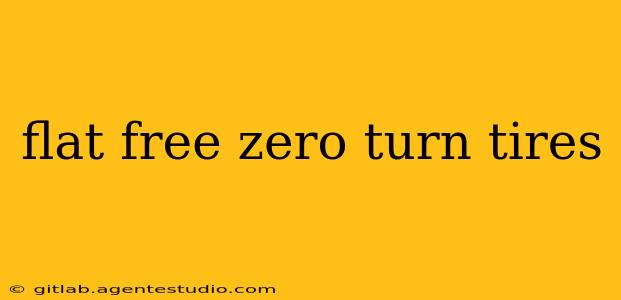Tired of constantly dealing with flat tires on your zero-turn mower? The frustration of a punctured tire mid-mowing session is a common problem for many lawn care enthusiasts. Fortunately, the advent of flat-free zero-turn tires offers a compelling solution to this persistent issue. This comprehensive guide will explore the benefits, types, and considerations surrounding flat-free tires, helping you make an informed decision for your mowing needs.
Understanding the Advantages of Flat-Free Zero Turn Tires
Flat-free tires, also known as solid tires or foam-filled tires, represent a significant upgrade for zero-turn mower owners. Their primary advantage is, as the name suggests, their resistance to flats. This translates into:
- Increased Uptime: No more downtime waiting for repairs or replacements. You can focus on mowing, not maintenance.
- Reduced Maintenance Costs: Eliminating flat tires significantly reduces the need for repairs, replacement tubes, and patching kits, saving you money in the long run.
- Improved Durability: Solid tires are typically more resistant to punctures and damage from sharp objects like rocks and debris, extending the lifespan of your tires.
- Enhanced Ride Quality (In Some Cases): While some users report a slightly harsher ride compared to pneumatic tires, advancements in technology have led to improved foam formulations that offer a more comfortable experience.
Types of Flat-Free Zero Turn Tires
Not all flat-free tires are created equal. Several variations exist, each with its own characteristics:
1. Foam-Filled Tires:
These tires are filled with a polyurethane foam, completely eliminating the need for air. They provide excellent puncture resistance but might compromise slightly on ride comfort depending on the foam density.
2. Solid Rubber Tires:
These are made entirely of solid rubber, offering exceptional durability and resistance to punctures. However, they generally provide the firmest ride.
3. Hybrid Options:
Some manufacturers offer hybrid solutions combining aspects of both foam-filled and solid rubber tires, aiming to balance puncture resistance and ride comfort.
Factors to Consider When Choosing Flat-Free Tires
Choosing the right flat-free tires involves weighing several factors:
- Mowing Terrain: If you mow on particularly rough or rocky terrain, solid rubber tires might be the most durable option. For relatively smooth lawns, foam-filled tires could offer a better balance of durability and ride comfort.
- Mower Type: Different zero-turn mowers have varying tire size requirements. Check your mower's manual for compatible tire sizes and specifications.
- Budget: Flat-free tires are generally more expensive than pneumatic tires upfront, but the long-term cost savings from reduced maintenance often justify the investment.
- Ride Comfort: While advancements have improved comfort, be aware that solid tires generally provide a firmer ride than pneumatic tires.
Installation and Maintenance of Flat-Free Tires
Installing flat-free tires typically involves removing the old tires and mounting the new ones. While some individuals might attempt this themselves, it's often best left to professionals, especially if you lack experience with tire changes. Maintenance for flat-free tires is minimal; regular visual inspections for any signs of unusual wear or damage are generally sufficient.
Conclusion: A worthwhile investment?
For many zero-turn mower owners, investing in flat-free tires is a worthwhile decision. The elimination of flat tires, reduced maintenance, and enhanced uptime significantly increase the convenience and efficiency of lawn care. By understanding the different types of flat-free tires and considering your specific needs and preferences, you can choose the optimal solution to keep your zero-turn mower running smoothly, season after season.

